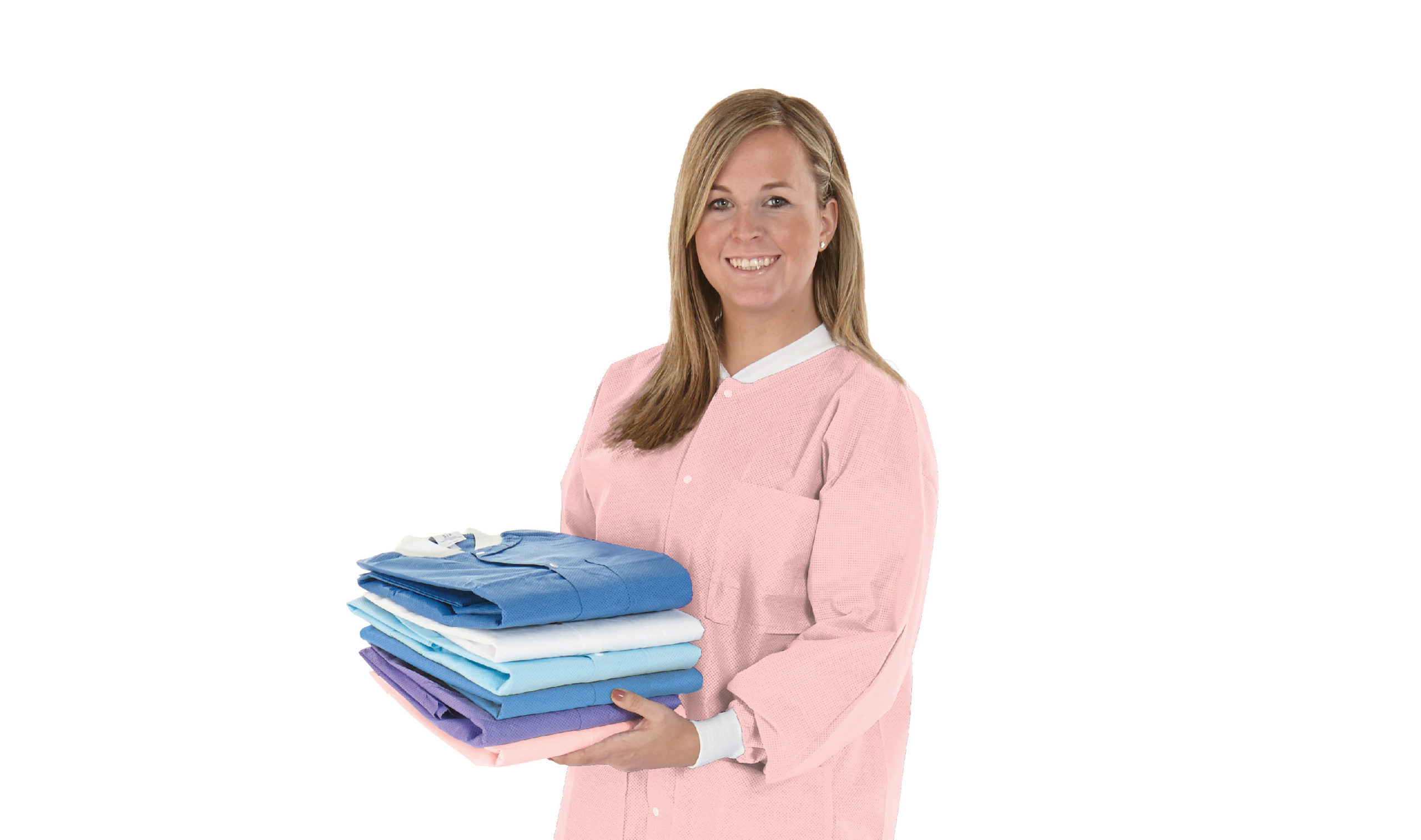À propos des blouses médicales
Les blouses médicales, souvent appelées blouses chirurgicales, blouses d’isolation ou blouses de procédure, constituent un aspect essentiel de l’équipement de protection individuelle du personnel travaillant dans les établissements de santé et un élément essentiel de tout protocole de contrôle des infections. Les blouses protègent le porteur contre les infections ou les maladies transmises par contact avec des matières liquides ou solides potentiellement infectieuses et l’empêchent de transmettre des micro-organismes aux patients.
En 2004, la FDA a reconnu la norme de consensus American National Standards Institute/Association of the Advancement of Medical Instrumentation (ANSI/AAMI) PB70:2003, « Liquid barrier performance and classification of protective apparel and drapes intended for use in health care facilities ».
La norme classe les niveaux de protection contre les liquides des blouses et autres vêtements de protection destinés à être utilisés dans les établissements de santé selon 4 niveaux. Les noms des produits n’étant pas normalisés, il est important que l’utilisateur choisisse sa blouse en vérifiant les étiquettes des blouses individuelles pour l’usage prévu et en fonction du niveau de protection désiré sur la base des niveaux de risque suivants :
- Niveau 1: Risque minimal, à utiliser, par exemple, pendant les soins de base, l’isolement standard, la blouse de couverture pour les visiteurs, ou dans une unité médicale standard.
- Niveau 2: Risque faible, à utiliser, par exemple, pendant une prise de sang, une suture, dans l’unité de soins intensifs (USI) ou dans un laboratoire de pathologie.
- Niveau 3: Risque modéré, à utiliser, par exemple, lors d’une prise de sang artériel, de l’insertion d’une ligne intraveineuse (IV), dans la salle d’urgence ou pour les cas de traumatisme.
- Niveau 4: Risque élevé, à utiliser, par exemple, lors de procédures longues et intenses en fluides, en chirurgie, lorsqu’une résistance aux pathogènes non aériens est nécessaire ou que des maladies infectieuses sont suspectées.
Types de blouses médicales
Blouses chirurgicales
Aux États-Unis, les blouses chirurgicales sont réglementées par la FDA en tant que dispositifs médicaux de classe II qui nécessitent une notification préalable à la mise sur le marché 510(k). Au Canada, toutes les blouses médicales (chirurgicales et d’isolation chirurgicale) sont classées comme des dispositifs médicaux de classe I et sont soumises à la réglementation des dispositifs médicaux.
Une blouse chirurgicale est un vêtement de protection individuelle destiné à être porté par le personnel de santé pendant les interventions chirurgicales afin de protéger le patient et le personnel de santé contre le transfert de micro-organismes, de fluides corporels et de particules. Toutes les blouses chirurgicales doivent être étiquetées comme telles et peuvent être utilisées pour tous les niveaux de risque (niveaux 1 à 4).
Les zones critiques sur une blouse chirurgicale sont les suivantes :
- Le devant du corps, du haut des épaules aux genoux.
- Les bras, du poignet au coude.
Blouses d’isolation chirurgicale
Les blouses d’isolation chirurgicale sont destinées aux situations présentant un risque modéré à élevé de contamination et nécessitant des zones critiques plus larges que les blouses chirurgicales. Comme les blouses chirurgicales, les blouses d’isolation chirurgicale sont réglementées par la FDA en tant que dispositifs médicaux de classe II nécessitant une notification préalable à la mise sur le marché 510(k). Une blouse d’isolation chirurgicale doit couvrir la plus grande partie du corps possible pour l’usage auquel elle est destinée.
Les zones critiques d’une blouse d’isolation chirurgicale sont les suivantes :
- Toutes les zones de la blouse d’isolation chirurgicale, à l’exception des attaches, des poignets et des ourlets.
Les zones critiques doivent répondre au plus haut niveau de protection contre les liquides pour lequel la blouse est classée et toutes les coutures de la blouse doivent offrir le même niveau de protection contre les liquides que le reste de la blouse.
Blouses non chirurgicales
Les blouses non-chirurgicales sont considérées comme des dispositifs médicaux de classe 1. En tant que telles, elles ne nécessitent pas d’examen préalable à la mise sur le marché. Les blouses non chirurgicales sont destinées à protéger les personnes qui les portent contre le transfert de micro-organismes et de fluides corporels dans des situations d’isolement de patients à risque faible ou minimal. Les blouses non chirurgicales ne sont pas appropriées pour être utilisées pendant les procédures chirurgicales, les procédures invasives ou lorsqu’il existe un risque modéré à élevé de contamination.
Comme les blouses d’isolement chirurgical, les blouses non chirurgicales doivent couvrir la plus grande partie du corps possible en fonction de l’utilisation prévue.
Les zones critiques d’une blouse non chirurgicale sont les suivantes :
- Toutes les zones de la blouse, à l’exception des liens, des poignets et des ourlets.
Les zones critiques doivent répondre au plus haut niveau de protection contre les liquides pour lequel la blouse est classée et toutes les coutures de la blouse doivent offrir le même niveau de protection contre les liquides que le reste de la blouse.
Normes de performance
Pour déterminer si une blouse convient à un usage particulier, il est important de consulter son étiquette pour confirmer qu’elle a été testée et qu’elle répond aux normes de performance pertinentes. Cependant, il est important de noter que la conformité aux normes reconnues décrites ci-dessous est volontaire pour les fabricants de dispositifs médicaux, qui peuvent choisir d’aborder les critères de performance pertinents d’une manière différente.
Normes de l’ASTM
L’American Society for Testing and Materials (ASTM) a établi des normes concernant l’intégrité du matériau utilisé pour fabriquer les blouses médicales, notamment la résistance au déchirement, la résistance des coutures, la production de peluches, la résistance à l’évaporation et la transmission de la vapeur d’eau. La FDA et Santé Canada acceptent toutes deux la conformité à la norme ASTM F2407, qui est un document général couvrant les normes suivantes :
- Résistance à la traction : ASTM D5034, ASTM D1682
- Résistance à la déchirure : ASTM D5587 (tissé), ASTM D5587 (non tissé), ASTM D1424
- Résistance des coutures : ASTM D751 (tissé ou tricot extensible)
- Production de peluches (ISO 9073 Partie 10)
- Transmission de la vapeur d’eau (respirabilité) ASTM F1868 partie B, ASTM D6701 (non tissé), ASTM D737-75
Normes ANSI et AAMI
Aux États-Unis et au Canada, la performance de la barrière en ce qui concerne la pénétration par des liquides ou des agents pathogènes transmis par des liquides est décrite par l’American National Standards Institute (ANSI) et l’Association of the Advancement of Medical Instrumentation (AAMI) : ANSI/AAMI PB70:2012 comme suit :
Niveau
- Niveau 1
- Niveau 2
- Niveau 3
- Niveau 4
Description
- Utilisé dans les situations à risque minimal.
- Fournit une légère barrière à la pénétration de petites quantités de fluide.
- Un seul test d'impact de l'eau sur la surface du matériau de la blouse est effectué pour évaluer la performance de la barrière de protection.
- Utilisé dans les situations à faible risque.
- Fournit une barrière à de plus grandes quantités de pénétration de fluide par éclaboussure et à une certaine exposition de fluide par trempage.
- Deux tests sont effectués pour évaluer la performance de la protection par barrière :
- L'impact de l'eau sur la surface du matériau de la blouse.
- Pressurisation du matériau.
- Utilisé dans les situations à risque modéré.
- Fournit une barrière contre de plus grandes quantités de pénétration de fluide par éclaboussure et plus d'exposition de fluide par trempage que le niveau 2.
- Deux tests sont effectués pour tester la performance de la protection par barrière :
- L'impact de l'eau sur la surface du matériau de la blouse.
- Pressurisation du matériau.
- Utilisé dans les situations à risque élevé.
- Empêche la pénétration de tous les fluides jusqu'à 1 heure.
- Peut empêcher la pénétration de VIRUS jusqu'à 1 heure.
- En plus des autres tests effectués aux niveaux 1 à 3, la performance du niveau barrière est testée avec un sang simulé contenant un virus. Si aucun virus n'est trouvé à la fin du test, la blouse passe.
Applicabilité
- Soins de base, unité médicale hospitalière standard.
- Prise de sang dans une veine, suture, unité de soins intensifs, laboratoire de pathologie.
- Prise de sang artériel, pose d'une perfusion, urgences, traumatisme.
- Résistance aux agents pathogènes, maladies infectieuses (non aéroportées), exposition à de grandes quantités de fluides sur de longues périodes.
Niveau
Description
Applicabilité
- Utilisé dans les situations à risque minimal.
- Fournit une légère barrière à la pénétration de petites quantités de fluide.
- Un seul test d'impact de l'eau sur la surface du matériau de la blouse est effectué pour évaluer la performance de la barrière de protection.
- Utilisé dans les situations à faible risque.
- Fournit une barrière à de plus grandes quantités de pénétration de fluide par éclaboussure et à une certaine exposition de fluide par trempage.
- Deux tests sont effectués pour évaluer la performance de la protection par barrière :
- L'impact de l'eau sur la surface du matériau de la blouse.
- Pressurisation du matériau.
- Utilisé dans les situations à risque modéré.
- Fournit une barrière contre de plus grandes quantités de pénétration de fluide par éclaboussure et plus d'exposition de fluide par trempage que le niveau 2.
- Deux tests sont effectués pour tester la performance de la protection par barrière :
- L'impact de l'eau sur la surface du matériau de la blouse.
- Pressurisation du matériau.
- Utilisé dans les situations à risque élevé.
- Empêche la pénétration de tous les fluides jusqu'à 1 heure.
- Peut empêcher la pénétration de VIRUS jusqu'à 1 heure.
- En plus des autres tests effectués aux niveaux 1 à 3, la performance du niveau barrière est testée avec un sang simulé contenant un virus. Si aucun virus n'est trouvé à la fin du test, la blouse passe.
Il est à noter que Santé Canada reconnaît également les normes de l’Association canadienne de normalisation (CSA) : CSA Z314 et la norme européenne EN 13795 en ce qui concerne les blouses médicales.
Choisir la bonne blouse
Selon le CDC, il y a trois facteurs clés à prendre en compte lors du choix d’un ÉPI en général :
- Type d’exposition anticipée : contact, éclaboussures ou pulvérisations ou grands volumes de sang ou de liquides organiques susceptibles de pénétrer dans les vêtements, ainsi que la catégorie de précautions d’isolement dont fait l’objet le patient.
- Durabilité et adéquation à la tâche : par exemple, la tâche nécessite-t-elle une blouse ou un gilet ; si une blouse est choisie, elle doit être résistante aux fluides, étanche aux fluides ou ni l’un ni l’autre.
- Ajustement : L’EPI doit être adapté à l’utilisateur individuel. Il incombe aux employeurs de s’assurer que tous les EPI sont disponibles dans des tailles appropriées pour leurs travailleurs.
Le CDC recommande les critères de sélection suivants, spécifiquement pour les blouses :
- Utilisation prévue : Les blouses d’isolement sont généralement préférables, mais pour les procédures où une contamination limitée est anticipée, un tablier peut suffire. Toutefois, si l’on prévoit une contamination des bras, il faut choisir une blouse. La blouse doit couvrir entièrement le torse, être confortable et avoir des manches longues qui s’ajustent bien aux poignets.
- Propriétés matérielles de la blouse : Les blouses d’isolation sont fabriquées en coton ou dans un matériau synthétique filé. Cela détermine si la blouse peut être lavée et réutilisée ou si elle est destinée à un usage unique (jetable). Les blouses d’isolation en coton et en synthétique filé offrent également divers degrés de résistance aux fluides, un autre facteur à prendre en compte lors du choix d’une blouse. Dans les situations où la pénétration de fluides est probable, il faut 3. utiliser une blouse résistante aux fluides.
- Risques pour le patient : Les niveaux de risque pour les patients déterminent si une blouse stérile est nécessaire ou si une blouse propre est suffisante. Les blouses propres sont généralement utilisées pour l’isolement. Les blouses stériles ne sont requises que pour les procédures invasives, comme l’insertion d’un cathéter central. Dans ce cas, une blouse stérile protège à la fois le patient et le personnel soignant.
Pourquoi les professionnels de la santé préfèrent les blouses Medicom
Bien que de nombreuses marques respectent les normes de l’industrie pour offrir une protection fiable, les professionnels de la santé préfèrent les blouses Medicom pour leurs qualités uniques, notamment :
- Des matériaux de qualité supérieure qui permettent au porteur de rester au frais et à l’aise.
- Des conceptions uniques qui offrent un ajustement personnalisé et une facilité de mouvement.
- Des caractéristiques spéciales qui garantissent une fermeture sûre et un enfilage et un désenfilage faciles.
- Une grande variété de styles, de longueurs, de tailles, de couleurs et de poids de tissu.
- Une qualité, une durabilité et un ajustement constants.
Medicom vous couvre de la tête aux pieds
Medicom offre une sélection complète de vêtements de protection, y compris notre AssureWear® VersaGown avec technologie Flexneck™, des blouses conformes à la norme AAMI PB70:2012, des blouses de plafond, des blouses imperméables, des blouses à boucle de pouce et des blouses de chimiothérapie, ainsi que des blouses et des gilets de laboratoire, des combinaisons et des couvre-manches, des bonnets à bouffant, des couvre-chaussures, des couvre-barbes et plus encore. Découvrez la gamme complète des vêtements de protection Medicom ici.



 Français (Canada)
Français (Canada)


